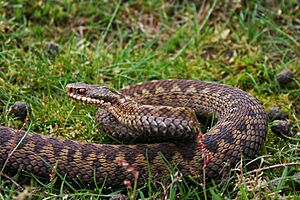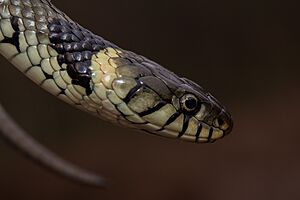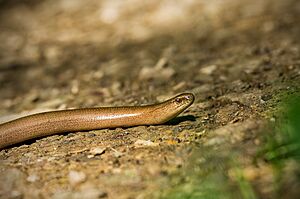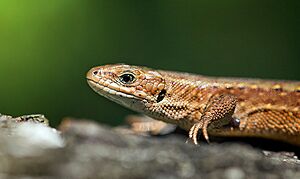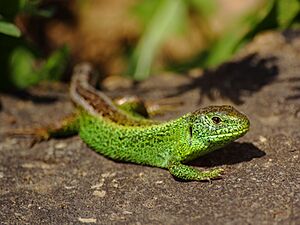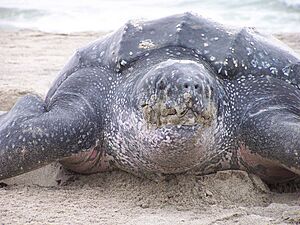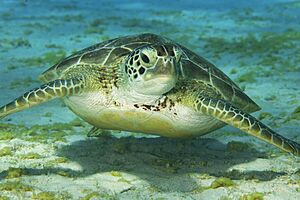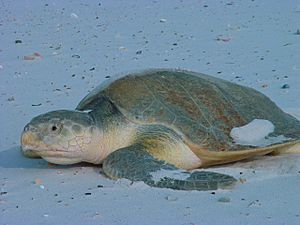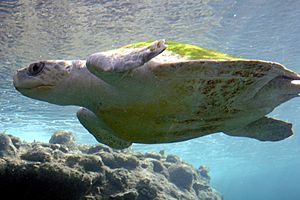List of reptiles of Great Britain facts for kids
The reptiles of Great Britain are amazing creatures! They are cold-blooded animals, which means their body temperature changes with their surroundings. They also have scales covering their skin.
Great Britain is home to three types of native snakes and three types of native lizards. You might also be lucky enough to see some sea turtles visiting the shores. Plus, there are at least seven different reptile species that have been brought to Great Britain from other parts of the world.
Contents
Snakes of Great Britain
Snakes are reptiles that don't have legs. They move by slithering along the ground. Great Britain has three native snake species.
Common Adder
The common adder (Vipera berus) is the only venomous snake found in Great Britain. It has a zig-zag pattern down its back. Adders usually grow to about 60-70 cm long.
You can find adders in many different places. They like heathland, moorland, and woodlands. They are shy and will usually try to get away if they sense you. Adder bites are rare and usually not dangerous to humans.
Barred Grass Snake
The barred grass snake (Natrix helvetica) is Great Britain's longest native snake. It can grow up to 150 cm long. It is usually green or brown with black markings. It often has a yellow and black collar behind its head.
These snakes love water! You can often find them near ponds, rivers, and lakes. They are excellent swimmers and eat amphibians like frogs and newts. Barred grass snakes are not venomous and are harmless to humans.
Smooth Snake
The smooth snake (Coronella austriaca) is a very rare snake in Great Britain. It is usually grey or brown with darker markings. It grows to about 60-70 cm long.
Smooth snakes are mostly found in sandy heathland areas. They are very secretive and hard to spot. They eat lizards and other small reptiles. Like the grass snake, the smooth snake is not venomous.
Lizards of Great Britain
Lizards are reptiles that usually have four legs and a tail. Great Britain has three native lizard species.
Slow Worm
The slow worm (Anguis fragilis) looks like a small snake, but it's actually a lizard! It has no legs and a smooth, shiny body. Slow worms are usually brown or grey and can grow up to 50 cm long.
Slow worms are common in gardens, woodlands, and grasslands. They like to hide under logs, stones, or compost heaps. They eat slugs, snails, and insects. If a slow worm feels threatened, it can drop its tail to escape, and the tail will grow back later.
Viviparous Lizard
The viviparous lizard (Zootoca vivipara) is also known as the common lizard. It is the only reptile native to Great Britain that gives birth to live young. Most other reptiles lay eggs. These lizards are usually brown with dark spots and can grow up to 15 cm long.
You can find viviparous lizards in many habitats, including heathland, grassland, and coastal areas. They are often seen basking in the sun to warm up. They eat small insects and spiders.
Sand Lizard
The sand lizard (Lacerta agilis) is Great Britain's rarest lizard. Males are bright green during the breeding season, while females are usually brown. They are larger than viviparous lizards, growing up to 20 cm long.
Sand lizards live in sandy heathland and coastal dunes. They are very rare because their habitat has been lost. They are protected by law. They eat insects and other small invertebrates.
Sea Turtles Visiting Great Britain
Sea turtles are amazing creatures that live in the ocean. While they don't live in Great Britain permanently, several species visit its waters. They usually come to feed or if they get lost.
Leatherback Sea Turtle
The leatherback sea turtle (Dermochelys coriacea) is the largest sea turtle in the world. It can grow over 2 metres long! It has a leathery shell instead of a hard one.
Leatherbacks often visit British waters in the summer. They come to feed on jellyfish, which are common here.
Loggerhead Sea Turtle
The loggerhead sea turtle (Caretta caretta) has a very large head and powerful jaws. Its shell is reddish-brown.
Loggerheads are usually found in warmer waters. They sometimes wander into British waters by accident.
Green Sea Turtle
The green sea turtle (Chelonia mydas) gets its name from the green fat under its shell. It has a smooth, oval shell.
Green sea turtles are mostly plant-eaters, feeding on seagrass and algae. They are rare visitors to Great Britain.
Hawksbill Sea Turtle
The hawksbill sea turtle (Eretmochelys imbricata) has a pointed, hawk-like beak. Its shell has beautiful patterns.
Hawksbills are usually found in tropical reefs. They are very rare visitors to British waters.
Kemp's Ridley Sea Turtle
The Kemp's ridley sea turtle (Lepidochelys kempii) is the smallest sea turtle. It has a round shell.
These turtles are critically endangered. They are very rare visitors to Great Britain.
Olive Ridley Sea Turtle
The olive ridley sea turtle (Lepidochelys olivacea) is similar to the Kemp's ridley. It has an olive-green shell.
Olive ridleys are also rare visitors to British waters.
Reptiles from Other Places
Sometimes, reptiles from other countries end up living in Great Britain. These are called introduced species. They might have escaped from pets or been brought here by accident.
Here are some introduced reptile species found in Great Britain:
- Red-eared slider (Trachemys scripta elegans) - a type of turtle often kept as a pet.
- European pond terrapin (Emys orbicularis) - another type of turtle.
- Common wall lizard (Podarcis muralis) - a fast-moving lizard.
- Western green lizard (Lacerta bilineata) - a large, bright green lizard.
- Aesculapian snake (Zamenis longissimus) - a non-venomous snake.
- Grass snake (Natrix natrix) - a different type of grass snake from the native barred grass snake.
See also
- Introduced species of the British Isles
- Lists of reptiles by region


